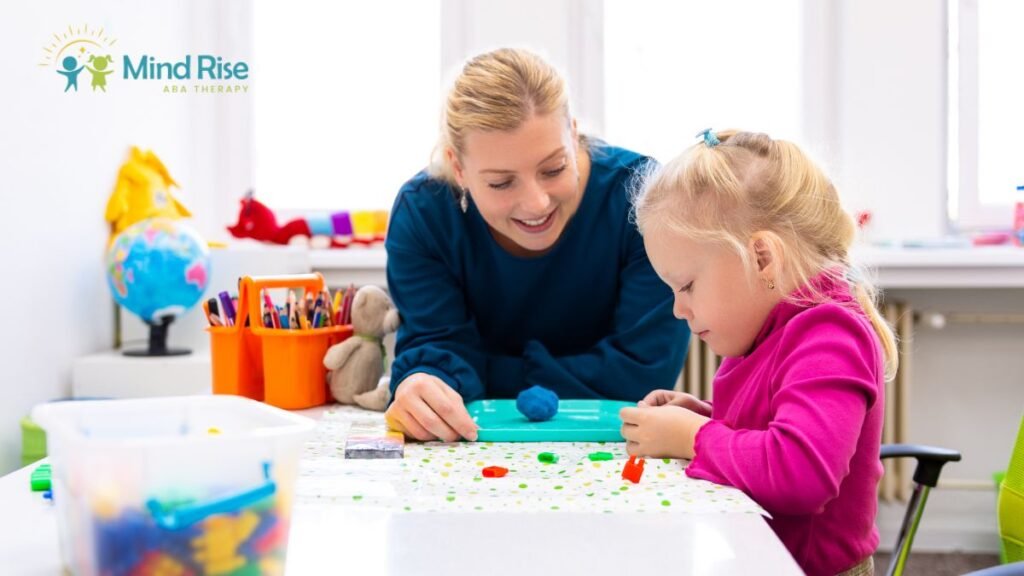Key Points:
- Automatic negative reinforcement happens when a behavior reduces discomfort or stress without another person being involved.
- ABA therapists identify these patterns and teach safer, more effective replacement skills.
- Parents and teachers can support therapy by tracking triggers, reinforcing coping skills, and making environmental adjustments.
Parents often notice behaviors in children with autism that seem puzzling. A child might hum loudly, cover their ears, or avoid certain activities even when no one else is interacting with them. At first glance, these actions can appear random or even defiant. In reality, many are linked to a behavioral process known as automatic negative ABA reinforcement.
Applied Behavior Analysis (ABA) uses reinforcement as a central principle for shaping behavior. Understanding automatic negative reinforcement is crucial because it explains why some behaviors persist and how therapy can help replace them with healthier alternatives. By learning this concept, families and educators gain practical tools to support children more effectively.

What Is Automatic Negative ABA Reinforcement?
Automatic negative ABA reinforcement occurs when a behavior removes or reduces an unpleasant internal experience. The reinforcement comes from the relief itself, not from another person. Examples include:
- Covering ears to block overwhelming sounds.
- Leaving a bright room to reduce eye strain.
- Rocking back and forth to lower anxiety.
- Refusing a food with a texture that feels uncomfortable.
The key factor is that the behavior produces immediate relief from discomfort, strengthening the likelihood of repeating that behavior in the future.
How It Differs from Other Types of Reinforcement
Reinforcement can be positive or negative and either automatic or socially mediated.
- Positive reinforcement: Something desirable is added (e.g., receiving praise after sharing).
- Negative reinforcement: Something unpleasant is removed (e.g., turning off a loud alarm).
- Automatic reinforcement: Reinforcement comes from the behavior itself, not from another person.
When combined, automatic negative reinforcement describes behaviors that directly remove discomfort internally, without needing help from others.
Why Automatic Negative Reinforcement Matters in ABA
Children with autism often face sensory sensitivities, difficulties with communication, or heightened anxiety. When these challenges feel overwhelming, they may develop coping behaviors reinforced automatically. Examples include:
- A child who escapes from handwriting tasks because the act of writing feels uncomfortable.
- A teenager who withdraws socially to avoid overstimulation.
- A child who avoids brushing teeth because the sensation is distressing.
If left unaddressed, these behaviors may interfere with learning, relationships, and independence. ABA focuses on uncovering these reinforcement patterns and teaching alternatives that provide relief in healthier ways.
Common Behaviors Maintained by Automatic Negative Reinforcement
Some behaviors are more likely to be connected to automatic negative reinforcement:
- Escape behaviors – Leaving classrooms or avoiding tasks.
- Sensory avoidance – Covering ears, shutting eyes, or refusing certain textures.
- Repetitive actions – Rocking or pacing to reduce internal discomfort.
- Aggression or self-injury – Attempts to stop overwhelming sensations or escape from stress.
It’s important to note that not every case of these behaviors is automatic; therapists conduct careful assessments to confirm the function.

Identifying Automatic Negative Reinforcement in ABA
Therapists use Functional Behavior Assessments (FBA) to identify whether automatic negative reinforcement is at play. They examine:
- Antecedents (triggers): What happens right before the behavior?
- Behavior itself: What exactly does the child do?
- Consequences: What happens right after the behavior?
If the behavior continues even when no one responds and consistently reduces internal stress, automatic negative reinforcement is considered the likely function.
Recent ABA practices also incorporate indirect assessments (interviews with parents and teachers) and direct observations in different settings to build a clearer picture.
ABA Strategies to Address Automatic Negative Reinforcement
Treating these behaviors requires a balance of reducing discomfort and teaching adaptive skills. Common ABA strategies include:
1. Functional Communication Training (FCT)
Children are taught to express discomfort in understandable ways. For example, instead of avoiding a classroom, a child can request, “I need a quiet break.”
2. Gradual Exposure and Desensitization
Therapists slowly introduce the child to uncomfortable stimuli while pairing the experience with positive reinforcement. This helps build tolerance over time.
3. Differential Reinforcement
Safer, alternative behaviors are rewarded, while less helpful behaviors are ignored or redirected. For instance, a child may earn reinforcement for using noise-canceling headphones instead of covering ears with hands.
4. Environmental Modifications
Adjusting the surroundings can reduce triggers. This may include dimming lights, lowering noise, or using adaptive seating to make tasks less overwhelming.
5. Teaching Coping Skills
Breathing techniques, sensory tools, and structured breaks give children healthier ways to achieve the same relief they previously sought through automatic reinforcement.

Real-Life Example
Consider a child who bites their shirt collar during reading time. Parents notice the behavior happens even when no teacher responds. After assessment, therapists determine that the chewing reduces internal anxiety. Intervention may include:
- Providing a chewable sensory tool as a safe replacement.
- Teaching the child to request short breaks.
- Reinforcing attempts to stay engaged in reading with positive feedback.
Over time, the child learns safer strategies while still getting relief from discomfort.
What Research Says
Recent findings show why addressing reinforcement functions is central in ABA:
- Differential reinforcement strategies reduced disruptive behaviors and increased classroom participation, showing how function-based approaches improve learning environments.
- Self-management interventions led to major gains in daily living skills for autistic individuals, with improvements carrying over across settings and time.
- Caregiver-implemented ABA strategies produced meaningful progress in children’s independence, while consistent parent involvement boosted generalization of skills beyond therapy sessions.
These findings underline how reinforcement-based interventions, when paired with caregiver support, create lasting and practical outcomes.
Role of Parents and Teachers
Parents and teachers are key partners in managing behaviors tied to automatic negative reinforcement. Parents can:
- Track behavior patterns with notes or apps.
- Encourage coping skills at home, such as using fidgets or requesting breaks.
- Share observations with therapists for better collaboration.
Teachers can:
- Allow flexible seating or quiet zones.
- Recognize early warning signs of distress.
- Reinforce replacement behaviors consistently in class.
When everyone works together, children receive the consistent support needed to build independence.
Challenges in Addressing Automatic Negative Reinforcement
There are obstacles in treatment:
- Relief is immediate, making the behavior powerful and persistent.
- Internal discomfort is hard to measure, unlike external rewards.
- Some behaviors may risk harm, such as self-injury, requiring urgent intervention.
Despite these challenges, ABA breaks down the process into manageable steps, helping children learn alternative skills gradually.
Promote Lasting Growth with ABA Therapy
Every child deserves strategies that go beyond short-term relief and lead to meaningful progress. ABA therapy services in Virginia give families structured support for addressing behaviors tied to automatic negative reinforcement.
At Mind Rise ABA, therapy emphasizes communication, coping skills, and independence so children can thrive in everyday life.
Get in touch today to learn how ABA therapy can help your child reduce stress, build confidence in daily routines, and create long-term positive change.

